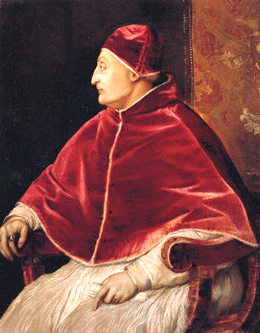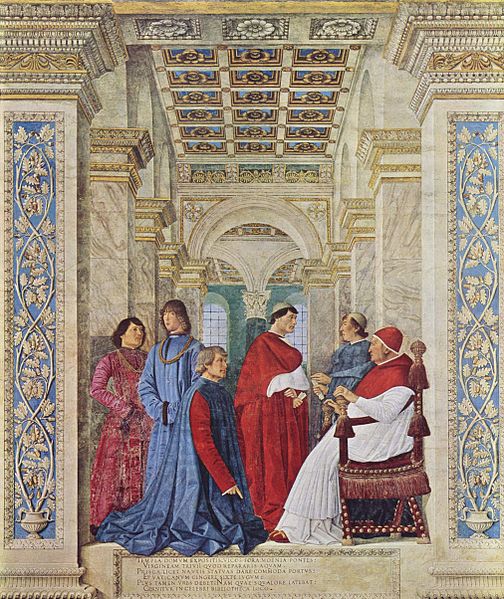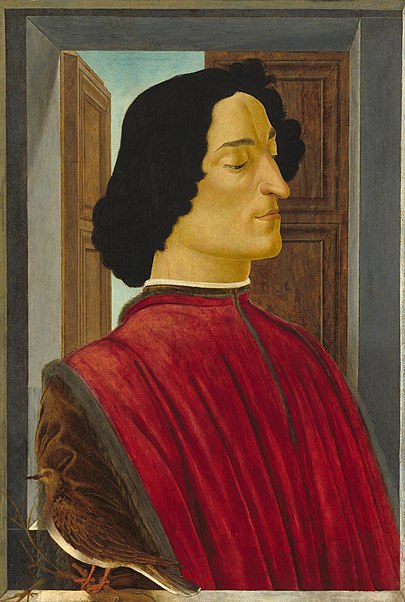 |
| Pope Sixtus IV |
Meddling in Unholy Matters
Sixtus took
to nepotism like a duck to water; his nephew Guiliano della Rovere[i] was made a cardinal within months of
Sixtus’ ascension to the papacy. Sixtus packed the College of Cardinals with
his own appointees, so much so that when he died only five were not beholden to
him.
Sixtus
created an apostolic chamber of 100 lawyers to supervise the financial affairs
of the Papal States and law cases in which the papacy had a financial interest.
The income was devoted to the pope’s family and to embellishing the ‘external glories’ of the Holy See; the Vatican library was
restored to its former glory and the Academy of Rome was re-opened. He also
ordered the building of the Sistine Chapel.
 |
| Sixtus appoints the Prefect of the Vatican Library |
Sixtus was
attacked by other princes of the church for allowing the Catholic church to
fall into disrepute. The Holy Roman Emperor, Maximilian I’s envoy Cardinal Archbishop
Zamometic was thrown into the Castel Sant’Angelo for criticising Sixtus and the
Curia.
Freed by a
friend, Zamometic called for a continuation of the Council of Basle to prevent the pope ruining the church, accusing
Sixtus of heresy, simony, wasting church patrimony and entering into a secret
alliance with the spawn of Satan, Mehmet II. Shortly before his death Sixtus
refused to consider a proposal from the Estates General of Tours, to reform the church, getting rid of fiscal abuse, plural benefices and
the much hated practice of ad commendam[ii].
An Ugly Little War
 |
| Guiliano de' Medici |
Sixtus’
attention was focussed on worldly matters; he, at the least, condoned the murder and attempted murder of Giuliano de’ Medici and his brother Lorenzo[iii] on Easter Day 1478. The death of Giuliano saw Lorenzo
take swift and merciless retribution against his enemies including Sixtus’
nephews.
Sixtus took
the opportunity to excommunicate Lorenzo and then the whole city of Florence when they failed to
hand the murderers over to the church. The excommunications failed to have the
expected effect, so Sixtus declared war on Florence. Naples and Siena wanted to help dismember the city state and they joined the pope in this
unholy war. Venice and Milan[iv] took the side of Florence and they
were soon joined by the papal fiefs of Ferrara, Bologna and Rimini.
One of the
conspirators, Bernard di Bandini de’Baroncello fled to Istanbul, taking refuge with
relatives. Mehmet had him arrested and the Florentine Senate were informed.
‘We have learned with great pleasure
how that most glorious prince [Mehmet] has seized Bernado Bandini[v],
most heinous parricide and traitor to his country, and declares himself willing
to do with him whatever we may want.’[vi]
Or Two or Three
 |
| Otranto |
The
Florentines joined the Venetians[vii] in making an alliance
with the Ottomans. Sixtus encouraged the war to reduce the powerful Colonna family. The capture of Otranto by the Ottomans in 1480 was a wake-up call for the pope. Sixtus removed
the interdict on Florence and Lorenzo was again of good standing in the church.
It was only the death of Mehmet the following year and the lack of interest in
further expansion by his heir Bayezid II that saw the threat of an Ottoman invasion recede.
The final
years of Sixtus’ life were embroiled in the War of Ferrara, instigated by Sixtus in his determination to avenge himself
against Lorenzo de’ Medici and all those who had defied him. Having bribed
Venice with the promise of one of his own papal fiefs, Ferrara; Sixtus and his
ally stood against Naples; Florence, Milan, Ferrara, Bologna, Rimini, Mantua
and Urbino.
The war saw
Ferrante of Naples[viii]
hire 1500 Turkish cavalry to fight his fellow Italians while Sixtus’ incompetent
nephew Giralomo Riario gamed away his army’s payroll playing dice. He then
attempted to rout out the Colonnas from their Roman strongholds, causing death
and mayhem to stalk the streets of Rome. Riario and his uncle refused to
consider discussing peace with their erstwhile allies the Venetians.
Death of a Pope
 |
| Innocent VIII |
Fortunately
for Italy Sixtus died on 12th August 1484; his death provoked two
weeks of rioting and plundering in Rome; mainly led by soldiers of the Colonna
faction. He left the problems highlighted by Zamometic and the Tours
Estates-General unsolved; they were to result in the Protestant Reformation.
Sixtus’
successor was Cardinal Marco Barbo, Innocent VIII. Rodrigo was unable to garner sufficient votes to ensure
victory; the Florentine envoy reported home that Rodrigo was;
‘So false and proud that
there is no danger of him being elected.’[ix]
And this was
despite bribes of up to 25,000 ducats[x] and promises of lucrative promotion.
Sixtus’ nephew Guiliano also failed to garner sufficient votes; he and Rodrigo
then both combined to ensure Barbo’s election.
Innocent was
remarkable mainly for his indulgence of his son Franceschetto. Otherwise he
came under Guiliano della Rovere’s influence whose militant stance led him to
being declared Captain-General of the Church. The Florentine envoy wrote to
Lorenzo de’ Medici;
‘Send a good letter to the
Cardinal of St Peter [della Rovere] for he is Pope and more than Pope.’[xi]
Rodrigo
remained as Vice-Chancellor in charge of the Curia but he did not fare so well
as his opponent. Innocent did make Rodrigo administrator of a monastery in Valencia but he had little
influence in papal policy.
While
Innocent was ensuring Franceschetto’s future[xii], Rodrigo was busy
creating new offices in his chancellery to sell off to the highest bidder. Even
the post of Vatican Librarian, previously awarded on merit, was sold. Rodrigo
sold pardons at inflated prices, the first 150 ducats[xiii] going to the Pope and
the remainder to his son.
Throughout
his career working for five popes Rodrigo collected many benefices, including
his last; sixteen days before Innocent’s death on 25th July 1492 Rodrigo
was made the first Archbishop of Valencia.
The Cardinal’s Children
 |
| Vanozza dei Cattanei |
Like many
churchmen Rodrigo had mistresses, the most enduring of these was Vanozza dei Cattanei. Rodrigo was an attractive man and
one Gaspar of Verona described him as;
‘Handsome, of a most glad
countenance and joyous aspect, gifted with honeyed and choice eloquence. The
beautiful women on whom his eyes are cast he lures to love him, and moves them
in a wondrous way, more powerfully than the magnet influences iron.’[xiv]
Rodrigo’s
first child was born in 1462; Pedro Luis was brought up in Spain. In 1485 Pedro
Luis was made Duke of Gandia, the hereditary Borja lands, having
purchased the duchy with the consent of the local nobles. He fought for
Ferdinand and Isabella during the wars of the Reconquista. Rodrigo fathered a further child, a daughter Isabella born
in 1467 and then Girolama born in 1469; both girls were brought up in Rome[xv].
It was
Vanozza who was mother to four of Rodrigo’s children; Rodrigo took up with
Vanozza after his return from Spain in 1472. Three years later Vanozza bore Cesare[xvi], the following year she had another
son Giovanni. Four years later Vanozza gave birth
on 18th April to another Borgia child Lucrezia and her final child of Rodrigo’s was Joffre, born in 1481 or 2[xvii].
Rodrigo’s
cousin Adriana de Mila acted as governess to the Borgia children; Adriana was
the wife of Ludovico Orsini[xviii]. Her daughter-in-law Giulia Farnese, married to Orsino Orsini, gave birth to two more of Rodrigo’s children; Giovanni in
1498 and Rodrigo in 1503. By 1493 Guilia was living with Adriana and Lucrezia
in a palace easily accessible from the Vatican.
Bibliography
At the Court
of the Borgia – Johan Burchard, Folio Society 1990
Italian
Dynasties – Edward Burman, Equation 1989
Lucrezia Borgia
– Rachel Erlanger, Michael Joseph 1979
Florence and
the Medici – JR Hale, Phoenix Press 2001
The Rise and
Fall of the House of Medici – Christopher Hibbert, Folio Society 2001
The Borgias
– Mary Hollingsworth, Quercus Editions 2014
The Borgias
– GJ Meyer, Bantam 2013
A History of
Venice – John Julius Norwich, Penguin Books 1982
Absolute
Monarchs – John Julius Norwich, Random House 2011
A
Renaissance Tapestry – Kate Simon, Harrap 1988
The March of
Folly – Barbara Tuchman, Cardinal 1990
www.wikipedia.en
[i]
Who was to become an inveterate enemy of Rodrigo’s
[iii]
In part for hanging an Archbishop in defiance of clerical immunity
[v]
Later hanged
[vi]
The Grand Turk - Freely
[vii]
The Ottomans proposed that the Venetians joined them in attacking King Ferrante
of Naples, as both he and the Pope were enemies of the both Venice and the
Ottoman Empire
[viii]
Who had changed his allegiance to join Sixtus, who had lost his Venetian allies
[ix]
The March of Folly - Tuchman
[x]
In 2013
the relative: historic standard of living
value of that income or wealth is £15,280,000.00 economic status value of that income or wealth is £487,900,000.00 economic power value of that income or wealth is £7,279,000,000.00 www.measuringworth.com
[xi]
The March of Folly - Tuchman
[xii]
A marriage was arranged to one of Lorenzo de’ Medici’s daughters
[xiii]
In 2013
the relative: historic standard of living
value of that income or wealth is £91,700.00 economic status value of that income or wealth is £2,927,000.00 economic power value of that income or wealth is £43,670,000.00 www.measuringworth.com
[xiv]
The Borgias - Meyer
[xv]
The mother(s) of all three children are unknown
[xvi]
Born sometime between September 1475 and April 1476
[xvii]
Vanozza had a fifth child Ottavio di Croce, the son of her husband Giorgio di
Croce from a marriage arranged by Rodrigo in 1480
[xviii]
Widowed at an early age Adriana sought her cousin’s assistance with
administering her husband’s large estate
No comments:
Post a Comment
Note: only a member of this blog may post a comment.